If you’re looking for a versatile whole wheat pizza crust that is fairly easy to make and actually tastes good, this one just might fit the bill. You can use this same dough to make ciabatta, focaccia, and mini baguettes.
This whole wheat pizza dough utilizes the delayed fermentation method to give the dough the resiliency and extensibility of white flour dough. By using this method, you get a dough that is soft and somewhat sticky but has wonderful stretching qualities.
Tip: This pizza dough is easy to make, but you do have to schedule the process — from start to finish it takes a couple of days. If you want pizza tomorrow, start the process tonight.
For this recipe, I recommend using a pizza stone. If you don’t have one, you can use the back of a baking pan.
Whole Wheat Pizza Dough
(makes 5 individual-size pizzas)
The recipe is adapted from Peter Reinhart’s Whole Grain Breads
Preparation Time:
Day 1: Soaker and biga, 20 minutes set up and mix; overnight autolyse
Day 2: 2 hours to de-chill biga; 12 to 15 minutes mixing; 1 hour fermentation (or hold overnight); 5 minutes per pizza, shaping and assembly; 5 to 8 minutes baking
Step 1: Making the Soaker
Ingredients:
- 1 3/4 cups whole finely ground wheat flour
- 1/2 teaspoon salt
- 3/4 cup plus 2 tablespoons water
Directions:
Mix all of the soaker ingredients together in a bowl for about 1 minute, until all of the flour is hydrated and the ingredients form a ball of dough. Cover loosely with plastic wrap and leave at room temperature for 12 to 24 hours. (If it will be more than 24 hours, place the soaker in the refrigerator; it will be good for up to 3 days. Remove it 2 hours before mixing the final dough to take off the chill.)
Step 2: Making the Biga
Ingredients:
- 1 3/4 cups whole wheat flour
- 1/4 teaspoon instant yeast
- 3/4 cup plus 2 tablespoons filtered or spring water, at room temperature (about 70°F F/21°F)
Directions:
Mix all of the biga ingredients together in a bowl to form a ball of dough. Using wet hands, knead the dough in the bowl for 2 minutes to be sure all of the ingredients are evenly distributed and the flour is fully hydrated.
The dough should feel very tacky. Let the dough rest for 5 minutes, then knead it again with wet hands for 1 minute. The dough will become smoother but still be tacky.
Transfer the dough to a clean bowl, cover tightly with plastic wrap, and refrigerate for at least 8 hours and up to 3 days.
About 2 hours before mixing the final dough, remove the biga from the refrigerator to take off the chill. It will have risen slightly but need to not have risen significantly in order to use it in the final dough.
biga (on right) after fermenting in refrigerator overnight
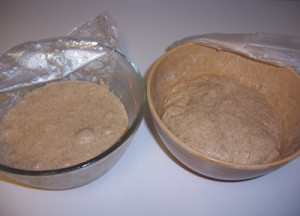 Step 3: Making the Final DoughIngredients:
Step 3: Making the Final DoughIngredients:
- Use all of the soaker
- Use all of the biga
- 7 tablespoons whole wheat flour
- 5/8 teaspoon salt
- 1 1/2 teaspoons instant yeast
- 2 1/4 teaspoons or 1 tablespoon honey or sugar or brown sugar (optional)
- 3 tablespoons olive oil
- extra whole wheat flour for adjustments
Directions:
Using a metal pastry scraper, chop the soaker and the biga into 12 smaller pieces each (sprinkle some of the extra flour over the pre-doughs to keep the pieces from sticking back to each other).
(like me), combine the soaker and biga pieces in a bowl with the 7 tablespoons flour and the salt, yeast, honey, and 2 tablespoons of the olive oil. Stir vigorously with a mixing spoon or knead with wet hands for about 2 minutes, until all of the ingredients are evenly integrated and distributed into the dough. The dough should be soft and slightly sticky; if not, add more flour or water as needed.
If you’re using a stand mixer, put the pre-dough pieces in the bowl along with the 7 tablespoons flour and the salt, yeast, honey, and 2 tablespoons of the olive oil. Mix with the paddle attachment (preferable) or the dough hook if need be and mix on medium-low speed, occasionally scraping down the bowl, for 2 minutes, until the pre-doughs become cohesive and assimilated into each other. Add more flour or water as needed until the dough is soft and slightly sticky.
Dust a work surface with flour, then roll the dough in the flour to coat. Knead the dough by hand for 3 to 4 minutes, incorporating only as much extra flour as needed, until the dough is soft and very tacky, verging on sticky. Form the dough into a ball and let it rest on the work surface for 5 minutes. Line a sheet pan with parchment paper or a silicon mat, then oil it with the remaining 1 tablespoon olive oil.
Resume kneading the dough for 1 minute to stregthen the gluten and make any final flour or water adjustments. The dough should have strength, yet still feel soft, supple, and very tacky, verging on sticky.
Divide the dough into 5 equal pieces. (I wanted bigger pizzas so I rolled mine into 3 balls instead of 5) Form each piece into a tight ball, and place the balls on the prepared pan. Roll the balls in the oil to coat the whole surface of each, then cover the pan loosely with plastic wrap.
Tip: If you need to hold the dough for later baking, you can put the pan in a plastic bag and refrigerater it to slow down the fermentation; the dough can stay in the refrigerator for up to 24 hours before it must be used.
Otherwise, proceed with the next step.
Preheat the oven as hot as it will go (with a baking stone if you have one; the dough will be ready to shape and bake in 1 hour, which is how long you should preheat a pizza stone). If you do not have a baking stone, use the underside of a sheet pan, or simply place the shaped dough on a sheet pan, assemble the pizza, and bake it on the sheet pan. Although this is the least recommended suggestion, in some cases it may be the most practical.
Shape the pizza dough.
Lightly top with sauce. I decided to par bake my dough a little bit before I put the sauce on it.
Add your favorite toppings. (I’m using a mix of pizza cheeses, pepperoni, onions and green peppers.)
Slide the topped pizza onto the stone (or bake directly on the sheet pan) and close the door. Wait 2 minutes, then take a peek. If it needs to be rotated 180 degrees for even baking, do so. The pizza should take 5 to 8 minutes to bake. If the top gets done before the bottom, move the stone to a lower shelf before the next round. If the bottom crisps before the cheese caramelizes, raise the stone for subsequent batches.
Remove the pizza from the oven and transfer to a cutting board. Wait 3 to 5 minutes before slicing and serving, to allow the cheese to set slightly.
Here are some additional resources for making pizza:
Happy Baking! Cathy

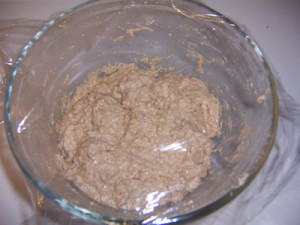
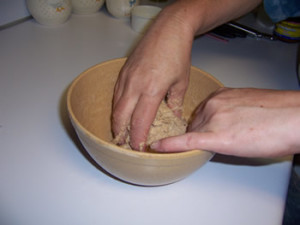
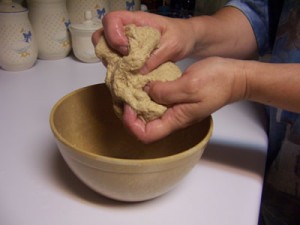
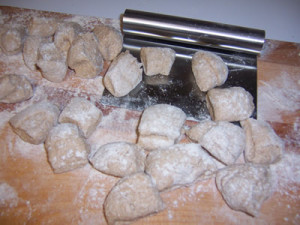
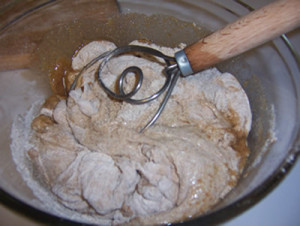
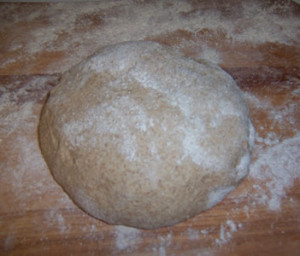
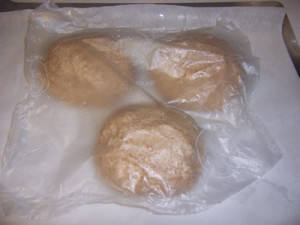
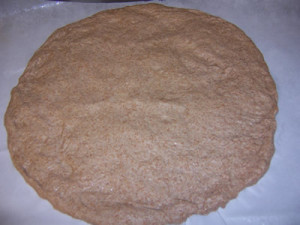
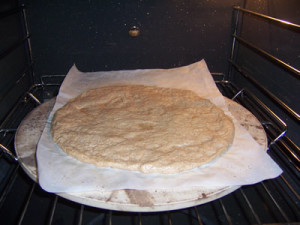
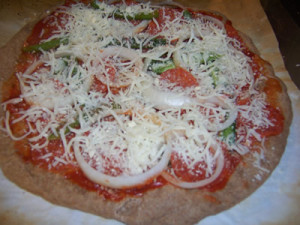
Emikat says
Thank you. I am fairly new to milling my own wheat and baking at home. I can’t wait to try this recipe. There are techniques and terms I have never heard of ( thanks for the reference link to terminology) I look forward to exploring your site more!!
Emikat says
I forgot to ask what type of whole wheat flour is used? Being new to this I purchased the 2 types I could find at my local store which are Hard Red and soft spring, I am still learning the differences between the different types of wheat and what kinds make what dishes best.
Thank you again.
Cathy (breadexperience) says
Hi Emikat,
I’m glad you like the blog. If you try the whole wheat pizza, let me know how it turns out.
I love milling my own whole wheat flour. For this recipe, I would use Hard Red Winter Wheat. The Soft Spring Wheat will be better for quick breads.
If you would like to learn more about bread baking terms, you can find a description on The Bread Experience site. Here is a link to the page: https://www.breadexperience.com/baking-instruction.html
Happy Baking!
learning pizza maker says
HiCathy,
Glad I found your blog! You have some very intersting pizza recipes. I experiment with pizza all the time and some of your ideas are really great! I also have a pizza making blog. Thanks for sharing your recipes. I will be trying out some of them soon.
Cathy (breadexperience) says
Hi there, thanks for visiting my blog. I love pizza. I do hope you’ll try some of the recipes and let me know how you like them.
Cathy